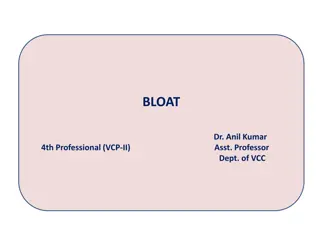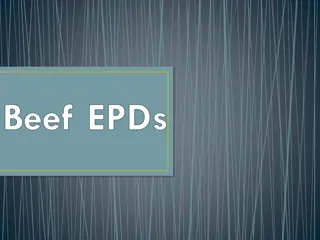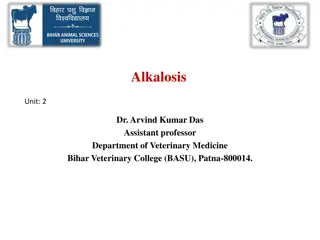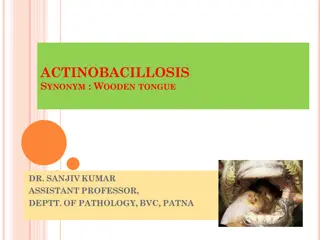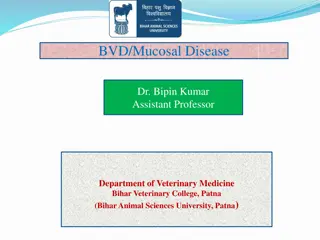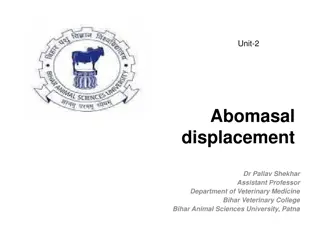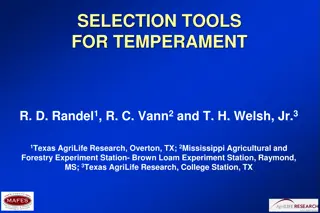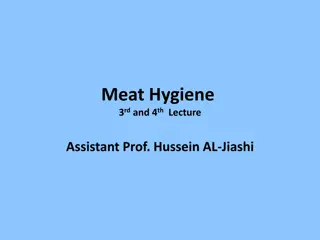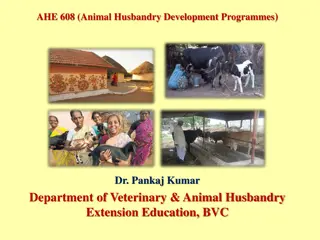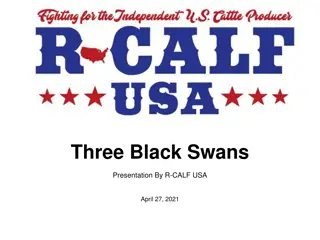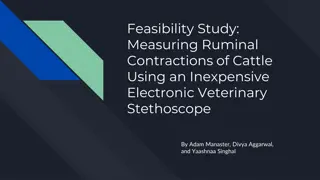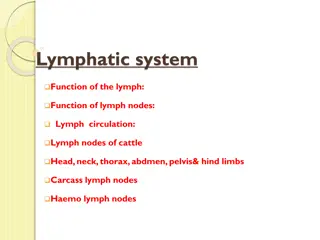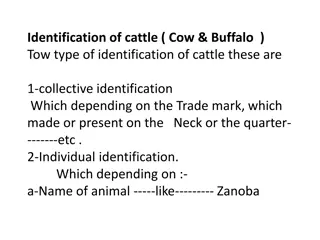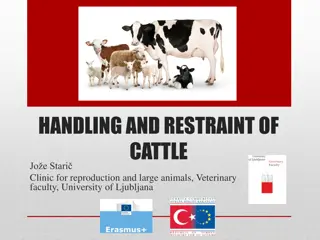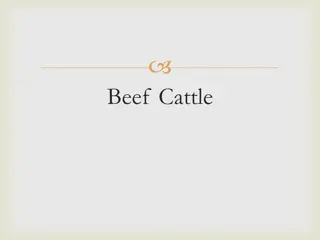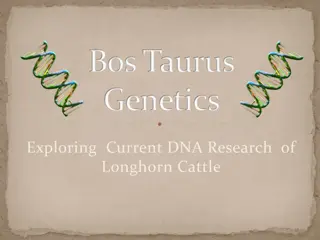Understanding Dehorning and Debudding Process in Cattle
Learn about the dehorning and debudding process in cattle, including when and why it should be done, suitable ages for calves, preferred methods, and the benefits of dehorning. Discover the techniques, tools, and considerations involved in ensuring the well-being of the animals and handling the process effectively.
Download Presentation

Please find below an Image/Link to download the presentation.
The content on the website is provided AS IS for your information and personal use only. It may not be sold, licensed, or shared on other websites without obtaining consent from the author. Download presentation by click this link. If you encounter any issues during the download, it is possible that the publisher has removed the file from their server.
E N D
Presentation Transcript
HORN Except polled breeds : Polled Hereford, Shorthorn In New born its modified epithelium as BUD grows outward from the skin Up to 2 months not attached with skull After 2 months get attached with skull Cornual process covered with cornified epitheium Frontal sinus get opens into horn at 4 to 6 months.
Why to dehorn/Debbud cattle? Can cause more severe injury to other cattle, especially in yards and during transports. Can damage hides and cause bruising which reduces the value of carcass. Are harder to handle in yards and crushes; Can be potentially more dangerous to handlers; Require more space at a feed trough and on cattle trucks; Are quiet to handle.
When to Debbud/dehorn? It is best to dehorn calves at less than two months of age. The most suitable age for calves, lambs and kids are 5-15 days old . They suffer less stress because they are more easily handled, and the preferred methods cause little or no bleeding, heal quickly, and do not result in any significant complications. Cattle should be dehorned on dry cool days to allow the wound to dry quickly with the minimum risk of infection. The best time is late afternoon, when fly activity is usually low. Never dehorn cattle in wet weather, because the healing rate is decreased and the risk of infection increased.
Debudding Restraint ~ Calf The calf's head is manoeuvred into the restraint, and then the chain is secured down over the calf's crown. The restraint design ensures easy access to the calf's When the job release the chain and the calf is on its way.. horns. done, is Application of caustics Caustic potash sticks or silver nitrate are used to rub of the horn bud. This method is very painful to the animal.
Calves up to two months old Hot iron Various hot iron dehorning tools are available, including wood fire heated, LPG heated, butane gas heated and 12- and 24-volt electric models. Generally these methods are best suited to calves up to about 8 weeks of age.
With the calf firmly restrained and the iron heated to a cherry red colour, apply the iron firmly over the emerging horn bud. Roll the hot iron over the horn bud several times so that a ring of tissue around the bud is burnt through the full thickness of the skin. Heat must be transferred evenly all the way around the horn bud to ensure that the horn growth tissue is destroyed. In due course the horn bud will drop off. The benefits of this method of dehorning are that it can be carried out at any time of the year. There is no loss of blood and no wound to become infected.
Knife A curved knife similar to a farrier s knife (but without a hook on the end) can be used for dehorning. Start the cut about 2 cm away from the base of the horn, then draw the knife through the skin towards and through the horn, slicing off the horn level with the skull. This will remove an elliptical piece of skin with the horn in the centre. If the cut has gone too near the edge of the horn so that the removed horn bud has an incomplete ring of hair, make another small cut to remove the skin to ensure no horn-forming tissue is left from which a scur (a rudimentary, deformed horn) may grow.
Avulsion of Horn Definition: Separation of horny covering of the horn core due to injury is known as avulsion of horn. Treatment: If bleeding is there, then a tourniquet is applied for about half an hour. The wound is cleaned with antiseptic lotion. Place a moist antiseptic pad soaked in the lotion and bandage is applied. On subsequent day, the bandage is removed and oily dressing or ointment is applied. The horny tissue develops completely within few months.
Fracture of horn In complete fracture of horn involving its distal portion may heal if properly immobilized. Immobilisation is difficult if the lower portion is involved. Fracture of horn causes haemorrhage in to the frontal sinus and bleeding from the nostrils is one of the symptoms noticed. A possible complication is accumulation of blood in the frontal sinus causing purulent sinusitis and empyema of the sinus.
Treatment: Amputation of horn is advisable. Incomplete fracture involving its distal portion may be set by applying plaster of paris bandage together with (metallic or wooden splints) or without splints. Complete fracture requires amputation of horn by flap method proxomal to the fracture site. Fracture of the broken tip of the horn is cut and a protective dressing is needed.
Sinusitis Sinusitis is a common sequel to dehorning in all species of animals. During amputation of horn, bone sawdust and rain can enter into the sinus through the opening. Sometimes, the animal may rub its head on the ground due to severe irritation leading to entry of more debris into the sinus tract. Clinical sign includes discharge run from the sinus opening when the animal lowers the head. Occasionally, the sinus will become heavily infected leading to profuse and purulent discharge.
Treatment Comprises draining by opening the dehorning site, flushing it copiously with a disinfectant, and tipping the head to drain it on a daily basis until it dries up and drainage ceases. Occasionally,systemic antibiotics are also required. Chronic sinusitis is best treated by trephination and lavage, administration of topical and systemic antibiotics and analgesics. If drainage persists, osteomyelitis may develop which can be best treated by surgical curettage.
Horn fissures A fissure involving the horn or horn core may develop as a result of direct injury and appear as its parallel to its long axis. Signs Inflammation of the affected part. Oozing of blood from the fissure part. Pus formation in the area if it gets infected. Treatment Application of cooling (ice pack), astringent and antiseptic lotion. In septic cases (presence of pus), horn should be cut and dress it aseptically.
Horn cancer It is malignant in nature and originate from the squamous cell lining of the core at the base of the horn. It is generally a disease of adult cattle between 5 to 10 years of age. The tumor is observed in more commonly in long horned , white coat breeds of cattle. Kankrej Bullocks are more susceptible. Etiology:- Trauma, chronic irritation, paints, solar radiation, virus.
Signs The affected animal show sign of painful manifested by keeping the head a little lower toward the affected side Constant shaking of the head. Rubbing of horn on some hard object or striking it with limbs. Slight slimy or bloody discharge from nostril or from the base of the affected horn. Tilting of the horn on the one side. Separation of horn occurs at the base of the horn and cauliflower like growth is exposed Which bleeds easily and gives offensive smell due to secondary infection.
Dehorning Definition:- The removal of the horn of an animal by methods which destroy or remove the keratin-producing cells and structures at the base of the horn. CLOT-Cornual Nerve-Lacrimal- Ophthalmic-Trigeminal Nerve
Treatment Amputation of horn. Anaesthesia and control Cornual nerve block. Hold the animal in the standing or in the recumbent position. Site:- Below the base of the horn after flapping the skin. OR Any level above the base of horn but below the seat of damage.
Technique An elliptical incision is given around the base of the horn. The skin on both sides of the incision is reflected to form a flap. The exposed horn is then cut closed to its base either using a saw or an obstetrical wire. Point firing or PP crystals can be used to arrest haemorrhage.
Complete growth along with affected part of the frontal bone should be chiseled and the wound curetted. The sinus is thoroughly irrigated with warm normal saline to flush out cancer tissue The skin flaps are apposed together with mattress suture using non absorbable suture material. A protective bandage should be applied after covering the wound with paraffin gauge. Appropriate measures should be taken to prevent complications. secondary
Treatment after dehorning A powder that contains a fly repellent is recommended if dehorning in the warmer months when flies are a problem. After the application of wound dressing powder (dusting powder) is often sufficient treatment; During the operation, animals may bleed freely for a short time. Heat cauterising of the wound of older calves is gaining acceptance as a means of reducing blood loss and drying out the wound. Dehorning pads are available. These are placed on the wound and reduce the amount of blood loss from the operation. The pads are left on the wound until they drop off with the scab. Cattle should be inspected regularly for the first 10 days and any infected wounds treated.


